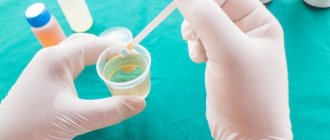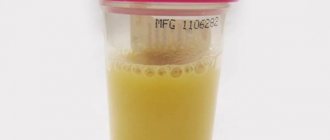Nitrites should not be detected in urine. The standard form for referral for urine testing also does not contain a line for entering information about such an indicator. If a doctor gives a special referral, as a result of which nitrites are determined in the urine, what does this mean? Let's consider the main issues.
- Nitrites in urine - what is it?
These substances are formed in the bladder from plant nitrates (components of plant foods) under the influence of bacterial enzymes. In a healthy person, the bladder and kidneys are sterile. Therefore, a positive test for nitrites in urine indicates the presence of microorganisms in the urinary organs - called bacteriuria and requires further examination of the body.
- Who has bacteriuria?
It most often affects children, young girls, women of childbearing age, people over 70 years of age, and men with prostate adenoma.
- There are nitrates in the urine, what does this mean?
There is no need to be afraid of this. Nitrates are normally present in urine after eating cabbage, carrots, and spinach. If there are no bacteria that convert nitrates to nitrites, then bacteriuria is not diagnosed.
However, there is an exception. Nitrites cannot be detected in the presence of anaerobic bacteria, ureaplasma, chlamydia, gonococci, streptococci, mycobacterium tuberculosis, and viruses in the urinary organs. In this case, only leukocytes increase in the urine.
What are nitrites and where do they come from?
Nitrites are formed in urine from nitrates (both are nitrogen compounds). Nitrates are found in large quantities in plant foods and enter the urinary tract directly from the blood. They are filtered in the kidneys and then gradually concentrated in the bladder. Bacteria are responsible for the formation of nitrites. However, microbes do not actually bear “responsibility” to the body for these same nitrites. Rather, it is simply a side effect of the presence of bacteria in the urine, their trace. Normally, there should be no nitrites in the urine, since there should be no bacteria. Therefore, the detection of nitrites is an indicator of the rapid proliferation of microbes in the urinary tract.
About nitrites
What do leukocytes in a child’s urine mean?
Nitrates or salts of nitric acid enter the human body with food. Most often these are vegetables or fruits that were fertilized during the growing process. They are also found in water and air. These salts are contained in the body of every person and do not harm him.
Nitrogen salts participate in nerve impulses and ensure the functioning of the nervous system. They are stable compounds and are excreted unchanged from the body through the kidneys. Their presence in the blood and urine is constant and does not cause concern.
When a focus of infectious inflammation and bacterial proliferation appears in the human body, nitrates are converted into nitrites. The main cause of the formation of nitrites are bacteria such as staphylococcus, enterococcus, streptococcus, E. coli, etc. They enter the urinary tract and cause inflammation.
What are nitrites? They are chemical compounds that are dangerous to human health. As a result of their accumulation, not only poisoning of the entire body begins, but also a disruption of the metabolic processes of oxygen and carbon dioxide in the tissues.
Detection of nitrites in urine requires diagnostics of the body and identification of foci of inflammatory processes.
During pregnancy
It is not for nothing that before each examination at the antenatal clinic it is necessary to take a urine test. This is the only way to diagnose unwanted changes in the body, including the appearance of nitrites. Their presence can lead to the following problems:
- development of intrauterine infection ;
- hypertensive crisis;
- metabolic disorders;
- the birth of a premature baby.
Expert opinion
Kovaleva Elena Anatolyevna
Doctor-Laboratory Assistant. 14 years of experience in clinical diagnostic services.
To prevent the further spread of pathology, you need to stop succumbing to stressful conditions, take vitamins, avoid hypothermia and monitor genital hygiene.
Take care of your health on time, and nitrites in the urine will no longer cause concern.
Why do they appear
It is noteworthy that the detection of unwanted compounds in urine does not always indicate the presence of serious diseases.
Perhaps you were just very worried or frozen before taking the test. Maybe your body simply does not have enough vitamins, or your immune defense has sharply decreased due to viral illnesses.
But most often the causes of nitrites in the urine are complex inflammatory processes affecting the urinary organs. These may be diseases such as cystitis, pyelonephritis, urethritis and others, which indicate the presence of bacteria in the kidneys, bladder, ureter and so on.
This does not always indicate a serious disease of the internal organs of the urinary system. The point is that sometimes the indicators can be false.
Or maybe the baby's foreskin is inflamed (which is quite common in newborn boys). Because of this inflammatory process, bacteria could enter the urine, thereby causing increased levels of nitrites.
Still, sometimes it can indicate serious violations. Which ones?
Why do you need a nitrite test?
An example of test strips that, among other things, allow you to perform an analysis for nitrites. But his results are considered very reliable. The price varies, but you can buy them very inexpensively (from about 4 dollars for 50 pieces). First of all, you need to understand that we are talking about an express test. That is, about receiving a “yes-no” answer. Either there are bacteria or there aren't. The researcher does not know exactly how many bacteria and what they are, what antibiotics they are sensitive to, or in which part of the urinary system they multiply. Therefore, no, even a very modern test strip for detecting nitrites will replace the same “banal” general urine test. Moreover, if the infection is caused by gram-positive bacteria and pseudomonads (and this happens quite often), nitrites will not be detected at all, because these two families of microorganisms do not process nitrates. But a lot of troubles are caused to a person (cystitis caused by gram-positive bacteria usually becomes chronic and difficult to treat).
Indications for the purpose of the study
OAM is certainly carried out as part of a preventive examination, annual medical examination, gaining access to certain types of activities, pregnancy management, and the patient’s initial hospitalization. In addition, any person, on his own initiative, can take a general urine test and interpret the results independently, but it is better to entrust this task to a qualified doctor.
OAM becomes a mandatory diagnostic test in the following cases:
- Signs of an inflammatory process in the genitourinary system - pathological changes in the color and smell of urine, disturbances in urination, pain in the lower back or lower abdomen;
- Symptoms of endocrine pathologies - sudden weight changes, sweating, thirst, hirsutism, drowsiness, irritability;
- Suspicion of the presence of an oncological process in the body;
- Newly occurring disorders of the gastrointestinal tract, cardiovascular system and other organs;
- Any existing somatic diseases (pancreatitis, diabetes, hepatitis) - OAM serves to control the treatment process.
If the interpretation of the results of a general urine test shows a significant deviation from normal values, the patient is prescribed additional studies, for example, ultrasound of the kidneys, urine analysis according to Zimnitsky or Nechiporenko.
Clinical urine analysis at home using test strips: pros and cons
I would like to talk about a lot today. And definitely don't turn this post into a review of a can of stripes. What self-control tools do you have at home?
In general, we always rather insist: anything like this should be kept at home, even if there are no prerequisites for this as such. Moreover, not just store it, but also systematically use it. A healthy person should have a glucometer, tonometer, scales, and test strips for rapid urine analysis at home - this is absolutely normal.
Systematic self-control is a great thing that will preserve your health and save money in the long run. You will definitely never, for example, go once a week and take general tests to the clinic, but once a week pricking your finger in the morning is no problem, getting on the scales once a day in the morning or taking a blood pressure reading in the evening is easy. And so on.
Everything diagnostic that is very easy to buy and easy to decipher should be at hand at home.
Decoding the results
This is the weirdest part, of course. We have already shown how this works using glucometers as an example. The task of modern “gadgets”, by and large, comes down not to being accurate, but to falling within a certain range of values.
Almost all modern devices have a legal error, which, in principle, reduces all work to the principle of a traffic light: green (normal) - orange (borderline value) - red (higher), etc. This is an absolutely normal story.
In this sense, urine test strips, for example, are the most harmless and honest: in general, any strips that work on the principle of changing color (there are a lot of them) are like that.
You can keep more or less correct data records by using only one device at all times. And there is certainly no point in double-checking one household appliance with another. Otherwise it will be something like this:
Both are accurate
In general, you need to focus on colors, and not on exact numbers, as practice shows. Let's say in the picture above the sugar level is basically the same, despite the spread of one and a half units. Of course, there are also devices where, firstly, accuracy is critical, and, secondly, which only a specialist can decipher. For example, a home ECG machine. But even there, if you remember, you can get a basic decoding at the “plus-minus-traffic light” level without leaving your computer:
There are almost no such problems with visual test strips
It’s definitely a traffic light here. In general, many test strips (even those that will be discussed) still provide the ability to identify specific numbers, but many indicators often fit into the scale “detected/not detected”, “a lot/little/very much”, etc. The task of analysis is to correctly decipher colors - this is the main problem of the visual test.
Some test strips can be used with special analyzers. These are electronic devices that eliminate all subjective errors, correctly recognizing colors. We wrote a review of one of these.
But in general, relatively neutral colors are quite contrasting.
On the left is a clean test strip, on the right is already analyzed.
The strips are compared with the scale: as a rule, all data can be read immediately from the jar. The vast majority of reagent zones in strips from different manufacturers are made the same way, so you can navigate using some general table.
We settled on DIRUI test strips - for them the scale looks like this.
It is also printed on the jar:
Is the data accurate?
Yes, there are no problems here. Moreover, most parameters in clinical analysis generally boil down to “detected or not detected.” Here, rather, it is necessary to say the following: test strips are somewhat inferior in information content. The general analysis on test strips comes down to 11 metrics - in the clinical sheet there are a little more of them. Let's compare.
In general, analysis in the laboratory is carried out in five directions, including biochemical, microscopic, microbiological, etc. It is clear that the data will be a little more complete. Plus, of course, the strips will not give any answer to the color and smell. But basically, the focus is on those same 11 parameters:
- Glucose (GLU)
- Bilirubin (BIL)
- Relative density (SG)
- pH
- Ketone bodies (KET)
- Hidden Blood (BLD)
- Protein (PRO)
- Urobilinogen (URO)
- Nitrites (NIT)
- Leukocytes (LEU)
- Ascorbic acid (VC)
In short:
Relative density (SG). Norm – 1010−1023
An indicator for assessing the ability of the kidneys to concentrate urine, or perform its main function, where 1023 is the minimum upper limit at which the kidneys are considered healthy. Result on test strips: 1020 - 1023 upon visual inspection
.
Urine acidity indicator (pH). Norm – 5.0−7.0
The indicator is often dictated by diet, but if there is a systemic deviation from the norm, it should raise questions. A decrease in the indicator is typical for conditions of dehydration, prolonged fasting, and diabetes mellitus. Elevated numbers may indicate renal failure or tumors of the genitourinary system. Result on test strips: up to 7
.
Protein (PRO). Norm – up to 0.033 g/l
Normally, it is not detected during clinical analysis, but there may be both episodic and systematic increases. Episodic surges can be associated with physical activity, work, and stress. Chronic may indicate urinary tract diseases (cystitis, urethritis), tumors, pyeloniphritis, etc. Not detected on test strips
.
Glucose in urine (GLU). There is no norm
With glucose, everything is more or less clear. Most often, its presence in the urine indicates diabetes mellitus. However, there may be other reasons for the appearance - from overeating to a heart attack. No test strips detected
.
Ketone bodies (KET). There is no norm
Acetone and related substances most often indicate decompensated diabetes. Should not be found in urine. A noticeable concentration can also occur against the background of binge drinking, acute pancreatitis and in some other cases. Test strips - not detected
.
Bilirubin (BIL). There is no norm
Normally, it is not determined, and any positive result may indicate irreversible disorders in the liver, from viral hepatitis and cirrhosis to tumors.
The test strips have a controversial value. They show a range of norms from negative to light orange (17), which can be read both as normal and as “weak presence.”
General clinical analysis did not find
.
Urobilinogen (UBG). Normal is 17 µcol/l or less
A bilirubin derivative should normally give a negative result. A positive test may indicate intravascular destruction of red blood cells. Urobilinogen also appears during resorption of hematomas, acute hepatitis, poisoning and liver tumors. Can be detected in various intestinal diseases. Test strips - positive. Coincided with clinical analysis
.
Nitrites (NIT). Norm - absent
Normally - none. Most often, a positive test indicates the presence of some bacteria that causes inflammation. Test strips - negative.
Blood in the urine (BLD). Norm - absent
You can determine a large amount by eye - the urine will change color. A small amount is not always something dangerous: it can be a consequence of consumption of berries, physical activity or stress. There are more dangerous pathologies: urinary tract infections, benign/malignant tumors, etc. Test strips - negative
.
Leukocytes in urine (LEU). Norm - single values
Leukocytes are always present in the urine, but most often the values are single: in clinical practice they are limited to the range of 0 - 5. Exceeding the norm may indicate cystitis, urethritis, or prostatitis. This is also a laboratory sign of urolithiasis. Test strips - within normal limits
.
Ascorbic acid (VC). Normal - present
Vitamin C is present in the body. So availability is the norm. There may be more ascorbic acid, there may be less. Actually, the analysis should confirm the presence within normal limits. Deviations can have different reasons. According to test strips - present
.
Comparison table: clinical test vs strips
| Data | Test strips | Laboratory analysis |
| Glucose | No | No |
| Bilirubin | Visually within normal limits | Absent |
| Bilinogen | Yes | Yes |
| Density | Visually from 1.025 - 1.030 | 1.029 |
| pH | Visually 6.5 | 6 |
| Ketones | No | No |
| Blood | No | There is nothing directly to compare it to |
| Protein | No | No |
| Nitrites | No | No |
| Leukocytes | Fine | Fine |
| Ascorbic acid | Fine | There is nothing directly to compare it to |
The accuracy and reproducibility of such test strips is quite high. At the same time, it should be noted that. Most often, test strips are sold in packs of 50 and 100 pieces. This is quite a lot, even for a family. But in fact, as such, the actual shelf life has no power over them. Even expired ones show reliable data. There's not much to spoil there. That is, this means that the thing is long-lasting.
Speaking of price. Depending on the number of pieces in the package, from 50 to 100, the price fluctuates by half and from 700 to 1500 and above. The test strips we worked with cost 1,500 rubles, there are 100 pieces in a package.
How often should this be done?
In general, from the point of view of “recoupment”, such a bank is quite profitable: the average cost of a general analysis in a private clinic is not high, but 300 - 350 rubles for 1 analysis will still be charged. A family of three or four people will pay for it with five stripes.
What to do with another 96 and how often should the indicators be monitored? Strictly speaking, despite the fact that this is the most accessible and cheapest diagnostic method, it is, of course, not useless. A general analysis can reveal some diseases of the kidneys, liver, and prostate diseases even at the asymptomatic stage:
General urine analysis:
- Diagnosis of kidney diseases: nephritis, nephrosclerosis, amyloidosis, urolithiasis, tumors
- Diagnosis of pyelonephritis, diseases of the bladder, prostate gland
- Detection of early signs of diseases
Usually prescribed:
- The first visit to the doctor is a mandatory examination, regardless of the current or suspected diagnosis
- For urinary tract diseases
- For kidney diseases
- As an annual preventive examination
- To assess the course of various diseases and evaluate the effectiveness of treatment
- After infectious diseases
In fact, not that often, but if you have something like marked test strips in the house, you can monitor the dynamics once a month. This is a prevention from the “it can’t get worse” series. There are also groups of users who can and should undergo such analysis more often. For example:
For control after operations, in patients with kidney stones during the prevention of recurrent stone formation, in pregnant women with the threat of infections, gestosis, in children with vesicoureteral reflux, chronic pyelonephritis, during differential diagnosis, etc.
At the same time, some of these patients may be immobile, for example, patients after operations, so taking the test at home in a calm, stress-free manner is one of the best solutions. In general, having such a self-control tool is not a stupid decision, and once or a couple of times a month for three or four family members, such a bank no longer seems “endless.”
Advantages and disadvantages
Of the disadvantages of any home self-analysis, self-medication seems to be the biggest. Here you need to be able to draw correct and unhurried conclusions, and have a good doctor for consultation.
From a functionality point of view, there are no negative pitfalls: the stripes determine the indicators quite accurately, and if there are no problems with distinguishing colors, then you will not draw unnecessary conclusions. But the human factor is, of course, always a minus: the lighting was wrong, I looked at it from the wrong angle, but still the colors are quite contrasting. Those who do not trust themselves can take another look at the home analyzer from our review. In Russia it costs 31,500 rubles, but this is more a solution for clinics.
The strips bend easily. This is important because urine collection containers most often have compact sizes:
But from this point of view, there will be no problems: the sample can be taken evenly and quickly by slightly bending the strip. The advantage is timely, quick results on key analyzed parameters with high accuracy. The main thing is to follow the instructions (there are plenty of them included). The main thing is the shelf life of the material - no more than two hours, and the period of visual analysis - 60-120 seconds.
You can also buy express strips for general urine analysis in our store. You can also use a 5% discount coupon: DIRUIH11
. Valid until the end of April or while supplies last.
Take care of yourself! And collect, if possible, a small family geek first aid kit.
Express methods for determining urine density
Today, there are methods that allow you to evaluate urine parameters at home. In cases where a person knows well the causes of his illness, test strips help monitor the condition and, if necessary, consult a doctor in time. Strips for rapid urine analysis are often used by patients with diabetes mellitus, diabetes insipidus and chronic renal failure.
Typically, a test strip can be used to evaluate one indicator. There are strips for determining the density of urine, the level of sugar and acetone in the urine, the presence of ketone bodies and nitrites, as well as assessing the acidity of urine.
Indicators that can be assessed using test strips:
- ketone bodies;
- urobilinogen;
- protein;
- red blood cells;
- specific gravity;
- acidity level;
- nitrites;
- presence of drugs;
The test strips contain a special indicator that changes color depending on the density of the urine. The test strip is dipped into a vessel with freshly collected urine for a few seconds. Then the strip is placed in a horizontal position and the result is assessed after a few minutes. Control color zones with corresponding relative density indicators are marked on the container. The color on the test strip is compared with this scale.
Causes of erroneous results on test strips:
- violation of the rules for storing test strips;
- expiration date of strips;
- a dirty container for collecting urine for analysis;
- urine temperature below 8°C and above 28°C;
- high concentration of ascorbic acid in urine;
If all the rules for using test strips are followed, the analyzes are very accurate. There are many test strips available on the pharmaceutical market for determining the density of urine.
Urine specific gravity test strip:
- Analyticon Combi-Screen;
- URISCAN;
- CITOLAB;
- Densitest;
- MultiStix;
- MultiCheck;
- DAC SpectroMed;
When choosing test strips, you must pay attention to the expiration date of the product. As the storage period expires, chemical indicators lose their activity and analysis results may be distorted.
The SG value in urine tests indicates the density or specific gravity of the fluid.
If the interpretation of the analysis results shows that the density of the biological material is reduced, then this can be considered a symptom of a malfunction of the renal system.
When the SG value increases, especially if the density norm is greatly exceeded, there is reason to suspect the presence of sugar or salts in the urine.
Decoding the SG value allows you to determine the presence or absence of pathology in the renal system.
For example, if SG is deviated from the norm to a lesser extent, then this fact may be a symptom of decreased kidney function, as a result of which toxins are no longer eliminated from the body.
The specific gravity of a biomaterial cannot be accurately assessed without performing a clinical urine test, but since random changes in indicators can occur, even a clinical test can be ordered several times.
A general analysis of biological fluid is a laboratory examination.
During the procedure, the specialist is able to evaluate the microscopy of urine sediment, study and record its physicochemical properties.
In addition to the SG value, deciphering the results of a general analysis of a biomaterial makes it possible to evaluate and compare the color and transparency of a biological fluid with existing standards and determine the degree of its acidity.
Also, a clinical urine test helps determine the presence and level of nitrates, glucose, bile pigment, hemoglobin complex protein, protein, urobilinogen and acetone bodies.
In microscopy of urine sediment, it is possible to identify and determine the concentration of bacteria, red and white blood cells, and microdetachments of the epithelium.
The purpose of conducting a clinical analysis of biological fluid is to diagnose diseases of the kidneys and genitourinary system, such as bilateral inflammation, urolithiasis, nephropathic amyloidosis, tumors.
The study is used to detect pyelonephritis, urinary tract and prostate diseases.
Density or specific gravity of urine is the relative ratio of 2 materials, with one serving as a standard, for example this could be distilled water.
The density of biological fluid is not constant, since during the day metabolic products are unevenly excreted in the urine in dissolved form.
Primary urine is formed as a result of glomerular filtration, while part of it is absorbed back into the bloodstream.
Subsequently, the kidneys produce a concentrate of secondary urine, and if there is a disturbance in this process, the density of the urine becomes lower.
The reason for this failure is the development of diabetes insipidus, some variants of nephritis and other diseases in the body.
Nitrites in urine in adults
Are nitrites in the urine different in women and men?
Of course no. Both the bacteria and the nitrites produced by these bacteria are exactly the same. The male and female urinary systems differ only in the final section: the urethra in women is short and relatively wide, and in men it is long and narrow. That is why laboratories make allowances for the different degrees of contamination of the material submitted by men and women. The contamination of the sample is of fundamental importance because during storage (for example, while awaiting transportation to the laboratory), bacteria first actively multiply, absorbing nitrates, and then die from a lack of nutrients, which is why the amount of nitrites also gradually decreases. The reliability of the result also changes.
Women are more likely to get bacteria into the bladder because they have a shorter urethra. This makes it easier for bacteria to enter the bladder. Some of the fair sex may encounter a similar problem 3 times a year.
The most common reasons for detecting nitrites in the urine of women:
- cystitis;
- urethritis;
- pyelonephritis.
The most common reasons for detecting nitrites in urine in men:
- BPH;
- cystitis;
- inflammation of the ureter (most often as part of urolithiasis with the addition of a secondary infection);
- pyelonephritis.
Positive test and absence of symptoms
Nitrites can appear in the urine only in one case: if the corresponding bacteria are present. But the absence of salts does not indicate the absence of infection, nor does the absence of symptoms.
- The first case is due to the fact that not all bacteria that cause genitourinary diseases convert nitrates into nitrites. In this case, only bacteriological examination can provide information about the nature of the disease.
- A high concentration of ascorbic acid, as well as urobilinogen, reduces the concentration of nitrites. As a result, their number may be too small for analysis.
- Another option is too short contact between bacteria and urine, which happens with frequent emptying of the bladder - usually in children.
It is possible that in the absence of symptoms, nitrites are detected in the urine. There are several explanations:
- The contamination occurred later: an unsterile container was used, hygienic procedures were not carried out to the required extent, the boy has inflammation of the foreskin, which distorts the data.
- The absence of signs may be due to the development of asymptomatic bacteriuria. In this case, not only nitrites, but also bacteria are found in the urine, and the patient does not experience any discomfort. Asymptomatic bacteriuria is rare - in 2-11%, mainly in women, which is again associated with a wide and short urethra. With age, the risk of getting sick increases.
What is specific gravity?
The sg norm in a urine test determines the proper functioning of the kidneys. Increased levels may indicate glucosuria or be a consequence of other pathologies. A reduced amount leads to serious complications.
Urine specific gravity is one of the most common tests. It depends on the number and type of solutions in the liquid. If an increased amount of sg is detected in the urine, what does this mean?
The specific gravity increases in direct proportion to the gravity of the substances dissolved in liquid excreta. Under physiological conditions, it depends on the material that is removed from the body by the kidneys in the last phase of their excretion - sodium chloride and urea, and to a lesser extent on other electrolytes (potassium, magnesium, calcium), uric acid, creatinine, glucose or protein.
Deciphering a urine test for sg will be useful for the following suspicions:
- dehydration;
- heart failure;
- excessive thirst;
- renal failure;
- urinary tract infections;
- hyponatremia or hypernatremia (low or increased amount of sodium).
The normal sg in urine analysis is in the range between 1.023-1.035 g/l. Ideally, sg should have a value of 1.002-1.030. When the number rises to 1.01, this may indicate moderate dehydration.
High density determines the presence of other additional substances in urine, such as protein, bilirubin, glucose, red blood cells, white blood cells, crystals and bacteria. If sg is greater than 1.035, the sample is either contaminated or contains a very high concentration of glucose.
The correct density value depends on factors such as age, gender and test method, as well as diet and fluid intake. Therefore, it should be remembered that only a doctor can interpret the test results.
Nitrites in the urine of a child
In order for microorganisms to synthesize as many nitrites as the test strip can detect, urine must remain in the bladder for 4 hours or more. As a rule, these conditions are satisfied by the first morning portion of urine. The daily portion can also be taken, but it is important to maintain this time interval between urinations.
Thus, in order to be absolutely sure that the result is correct, you need to give concentrated urine. However, in practice this is not always feasible. For example, if a child with a slight increase in body temperature is suspected of having an acute respiratory viral infection, they begin to actively drink it, according to the pediatrician’s recommendation. Urination becomes more frequent, urine becomes less concentrated, even the “first morning” urine. And, when the doctor thinks about a possible urinary infection and sends the child for analysis, the laboratory determines a large number of leukocytes, red blood cells, and even protein in the sample - but nitrites, as well as bacteria, may be absent there. Ideally, of course, to avoid a false negative nitrite test result, fluid intake on the eve of urine collection should be limited.
Nitrites in infants
Urine taken for analysis from infants must be delivered to the laboratory as quickly as possible, and here's why:
- Collecting an analysis is usually difficult: children do not understand attempts to fit a urine bag or induce urination over any container. Thus, the likelihood of bacteria getting into the urine from the baby’s skin and adult’s hands increases many times over.
- Careful hygiene of the urethra is also difficult.
- In boys under one year of age, there is a high probability of inflammation of the foreskin, which means additional contamination of urine with bacteria. The likelihood of a false positive result increases.
In the vast majority of cases, bacterial infection in infants is localized in the bladder, and, interestingly, there are often cases of “mixed infection” - a combination of bacterial growth with active reproduction of various herpes viruses in the bladder.
Treatment
The presence of nitrites is only one symptom of infection with certain bacterial infections. Moreover, these data do not even make it possible to find out which pathogen caused the disease. To make a diagnosis, bacterial culture of urine, ultrasound of the kidneys and ureter, ultrasound of the bladder, and so on are prescribed. In accordance with the data obtained, a course of treatment is developed.
Therapy usually involves antibiotics and vitamin complexes. Medicines are prescribed only by a doctor. One should take into account not only the underlying disease, but also all concomitant ailments, the patient’s age, and general condition.
- So, for cystitis, furagin is prescribed - it is used for almost all infectious and inflammatory diseases of the excretory system, or palin - an antibiotic of the quinol group. Treatment is supplemented with ibuprofen if cystitis is accompanied by severe pain, as well as herbal remedies - cystone, for example.
- Treatment of pyelonephritis is much more difficult and takes more time. Depending on the type of pathogen and sensitivity to a particular antibiotic, a variety of drugs are prescribed: from ampicillin - a representative of penicillins, to tetracyclines and aminoglycosides - amikacin, for example. As a rule, the antibiotic is administered intravenously or intramuscularly. To improve blood circulation in the kidneys, therapy includes appropriate medications - chimes, trental, heparin. For pain relief, non-steroidal anti-inflammatory drugs are prescribed - Voltaren is best, as it is the least toxic.
Treatment may be accompanied by physiological procedures - electrophoresis, paraffin baths, diathermy, as well as herbal medicine.
Nitrites in urine are a sign of disease caused by bacterial infections. For such indications, an examination should be carried out immediately, even if no external symptoms are observed. The detection of nitrites during a general urine test is the reason for prescribing the following studies.
Reference values
Physical characteristics:
- COL – pale yellow, straw.
- CLA is the obvious one.
- The smell is characteristic.
- PH – 4.8-8.0 (normal is about 6.5).
- SG – in urine analysis the norm is 1.015-1.030 kg/l.
Biochemical characteristics:
- PRO – absent (depending on the test method, the result can be given in the form of a concentration, for example, 100 mg/l or with “+” signs - the more of them, the higher the protein level).
- GLU – negative (can also be represented in physical units or mathematical symbols).
- KET – absent (presence is shown in “+”).
- BIL – negative.
- URO – in urine analysis the norm is 5 mg/l.
- Nitrite is negative.
- Hemoglobin and myoglobin are absent.
Microscopic examination (urine sediment):
- BLD – 0-3 in the field of view, when using test strips the amount is expressed as “+” symbols.
- LEU – 0-5 in the field of view, when using test strips, the results are also indicated in symbols.
- Epithelium – absent or 15-20 cells.
- Crystals – absent or a small amount of uric acid, oxalate and calcium phosphate.
It should be noted that reference values may vary slightly depending on the laboratory methods used.
Golden rules for getting tested for nitrites:
- If possible, reduce fluid intake on the eve of the test;
- on the eve of the analysis, include carrots, cabbage, and leafy vegetables in the diet;
- exclude for 3 days products containing ascorbic acid and preparations containing vitamin C (this reduces the concentration of nitrites);
- - the analysis is not carried out during antibiotic therapy and 10 days after completion of the course of this therapy;
- the analysis is not carried out when treating with phenazopyridine drugs (this is a remedy for pain and burning in inflammatory diseases of the urinary system).
Norms and interpretation of urine analysis
As the interpretation of the results of a clinical urine test shows, SG (specific gravity) can be considered an important physical characteristic of a biological fluid.
This indicator allows you to determine the density of a substance per unit volume.
The normal SG for an adult is 1.020, depending on specific factors it can vary from 1.018 to 1.024.
For example, if drinking regular water has a specific gravity of 1.000, then it is safe to say that urine will be heavier than water.
This fact is simple to explain: the composition of the biological fluid includes salts, urea, uric acid and creatinine, which affect the SG of urine.
As soon as it shows that the permissible SG norm is significantly reduced or increased, it means that physiological changes are occurring in the human body.
The density of urine and the concentration function of the kidneys depend on the age of the person and the anatomical features of his body. In a child, the relative density of urine will also depend on age.
For example, for a one-day-old newborn child, the SG norm will be 1.008 - 1.018. Up to six months, these indicators change and take on the following form – 1.002 – 1.004.
For a child aged 6–12 months, the SG norm in the analysis will be 1.006–1.010. At 3–5 years, this norm increases from 1.010 to 1.020. In a child of 10 or 12 years of age, the normal SG in urine is 1.011 - 1.025.
Interpretation of the results of children's and adult urine tests allows us to assess the functioning of the renal system.
The fact that the SG norm in adults can vary significantly depends on the food a person eats and the amount of liquid he drinks per day.
If the SG norm in the general analysis of morning urine is 1.018, then a slight deviation from the specified norm will not mean that the concentrating ability of the kidneys is impaired.











